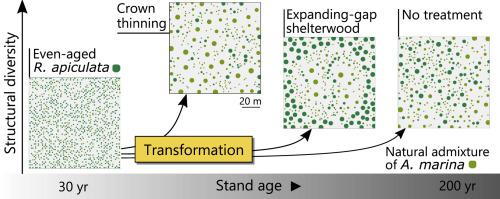Estuarine, Coastal and Shelf Science ( IF 2.8 ) Pub Date : 2020-06-29 , DOI: 10.1016/j.ecss.2020.106886 Michael Jenke , Aor Pranchai , Ronny Peters , Uta Berger

|
Mangrove rehabilitation efforts regularly intend to re-establish the former canopy cover quickly by establishing even-aged monocultures. However, there are concerns that these stands are less resilient to disturbances than structurally diverse forests and cannot provide ecosystem services as effectively. The objective of this study was to identify silvicultural systems for the transformation of even-aged Rhizophora apiculata stands to more irregular and species-diverse stands.
The individual-based forest model KiWi was used to simulate the dynamics of a 1-ha sized Rhizophora apiculata stand under (1) passive management without intervention, (2) stand clearcutting, (3) group clearcutting, (4) expanding-gap shelterwood, and (5) crown thinning. As observed in the field, seedlings of the less shade-tolerant tree species Avicennia marina regenerated naturally under the canopy of R. apiculata. The transformation process was considered complete at the onset of the steady state characterized by a multi-layered forest structure as well as a stable basal area and stem size distribution.
Without intervention, stands entered a steady state, on average, after 226 years under poor site conditions, or 179 years under good conditions. Silvicultural systems that required multiple entries, specifically expanding-gap shelterwood and crown thinning, halved this time by creating multi-layered stand structures while retaining a partial canopy cover. Moreover, continuous crown thinnings were necessary to maintain a species-diverse upper canopy. In contrast, small group clearcuts developed into two-layered stands and were ineffective. The removal of the upperstory through a stand clearcut or a large group clearcut reversed the initial planting arrangement but could develop into irregular stand structure only if propagules were supplied uninterruptedly. Intense forest operations were necessary to accelerate the transformation of even-aged mangrove stands. Forest managers should consider the potential future costs of transformation when planting even-aged stands instead of assisting the natural regeneration of former mangrove sites. Silvicultural field trials are proposed for the development of detailed guidelines.
中文翻译:

模拟的实验是将均匀年龄的红景天转化为不规则和多样化的红树林的造林方法
红树林恢复工作通常旨在通过建立均匀年龄的单一文化来迅速恢复以前的树冠覆盖。但是,令人担忧的是,这些林分比结构多样的森林对干扰的抵抗力更弱,并且不能有效地提供生态系统服务。这项研究的目的是确定造林系统,以将平均年龄的Rhizophora apiculata林分转变为更不规则和物种多样化的林分。
基于个体的森林模型KiWi用于模拟以下情况的1公顷大小的Rhizophora apiculata林分的动态:(1)无需干预的被动管理,(2)林分砍伐,(3)组林分砍伐,(4)扩展间隙的防护林,以及(5)冠变薄。如在田间观察到的,耐荫性较差的树种Avicennia marina的幼苗在R. apiculata的树冠下自然再生。在以多层森林结构为特征的稳定状态的开始,认为转化过程已经完成,并且具有稳定的基础面积和茎秆大小分布。
在没有干预的情况下,在恶劣的场地条件下平均经过226年或在良好的条件下平均需要179年之后,林木平均进入稳定状态。要求多次进入的造林系统,特别是裂隙的防护林和树冠变薄,这次通过创建多层林分结构同时保留了部分冠层覆盖而减半了。此外,连续冠变薄对于维持物种多样的上冠层是必要的。相比之下,小规模的砍伐活动发展成为两层林分,效果不佳。通过林分清除或大批林分清除清除上层植物会颠倒最初的种植安排,但只有在不间断地提供繁殖体的情况下,才能发展成不规则的林分结构。激烈的森林作业对于加速均匀老化的红树林林分的转化是必不可少的。种植均匀年龄的林分时,森林管理者应考虑未来的潜在转换成本,而不是帮助以前的红树林地进行自然更新。建议进行造林现场试验,以制定详细的指南。



























 京公网安备 11010802027423号
京公网安备 11010802027423号